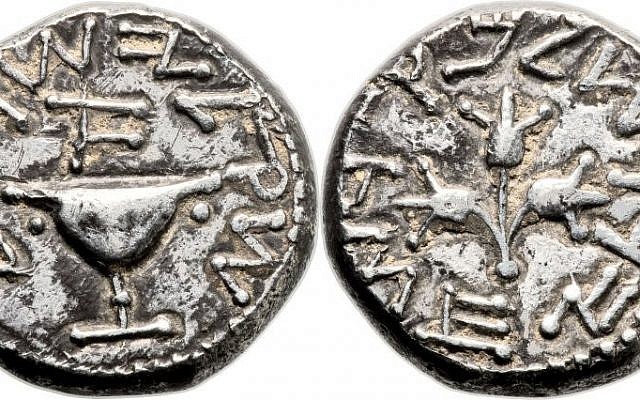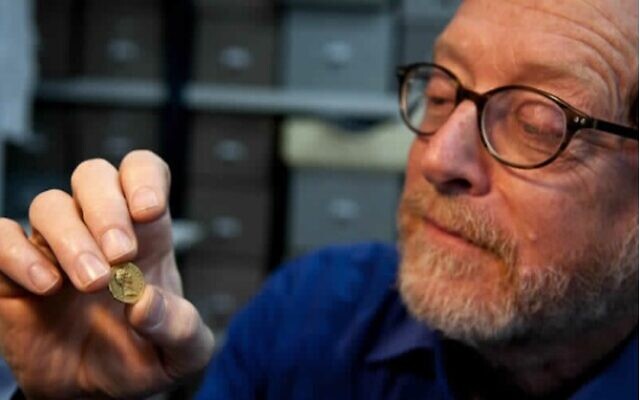There are some 750,000 coins stored in one room in a well-protected Israel Antiquities Authority vault and Donald T. Ariel, the head of the IAA’s Coin Department, stands watch over them all.
Ariel, who immigrated to Israel from the United States, has headed the department since 1991. He is the editor of the Israel Numismatic Research journal and serves as the coin expert on several ongoing excavations in the country. He took The Times of Israel Community on a virtual tour of the history of Holy Land coinage and pulled out some of the IAA’s treasures during a recent Behind the Headlines conversation.
The foundation of the coin collection is housed in mahogany wood boxes built by the British Mandate almost 100 years ago. The original boxes stand to one side, segregating the collection, which was amassed through purchases from coin dealers, versus the excavated coins the IAA holds in boxes made for buts and bolts that are made in the coastal Israeli city Holon.
“They’re perfect for what we do and each coin is in an envelope,” explains Ariel matter-of-factly.
The IAA collection spans from the beginning of coinage at the end of the 7th century BCE until today — with some registered coins dating to the 1970s and 1980s. The bulk of the coins date to the Hellenistic-Seleucid-Hasmonean period of the 2nd and 1st centuries BCE, and there’s a second peak in the 4th and 5th centuries CE, the early Byzantine period, says Ariel.

Head of the Israel Antiquities Authority’s Coin Department Dr. Donald T. Ariel displays part of the British Mandate coin collection. (Courtesy IAA)
The coins in the Mandate period collection were largely purchased, a practice discontinued by the State of Israel.
“The Mandate authorities had a budget to buy coins. They went to the Old City and they would buy beautiful coins for very cheap back then. The State of Israel does not have any budget to buy coins, which I think is terrific: We have concentrated on working on coins from excavations as they have much more value because you can learn from the strata that the coins are found in, we learn from the objects found with the coins, and we’re able to date the archaeological excavations and also learn about coin currency. These are things you cannot learn from purchased coins,” he says.
While the focus of the coin department’s work is on research, Ariel explains that “at any one time we have 5-10,000 coins on exhibition in different places. We’re involved in researching the coins and in publishing them. We have published already a quarter of all the identified coins in the collection.”
Before there were coins there were proto-coins, says Ariel. People would take pieces of silver and weigh them on a balance — usually from broken jewelry.

Head of the Israel Antiquities Authority’s Coin Department Dr. Donald T. Ariel displays trays of coin collections. (Courtesy IAA)
“This is the way Abraham paid for the Tomb of the Patriarchs. He weighed 400 shekels. There were no coins at the time. He weighed pieces of silver,” says Ariel.
The Athenian tetradracham formed the basis or template for many subsequent coins in the ancient world. On one side is the goddess Athena and on the other an owl, her signature animal. Ariel displays two examples, one minted on the island of Kos that was found under the Begin Center in Jerusalem, and another that Ariel found himself in the 1980s in the City of David excavations, which is from Lycia and dates to circa 475-440 BCE.
As the first coins were struck in the southern Levant, it was still unclear how much they were in use and by whom. That changed when local mints sprung up.

Head of the IAA’s Coin Department Dr. Donald T. Ariel searches among the collections 700,000+ coins. (Courtesy IAA)
“Even though there were coins circulating, we don’t know how many people understood what coinage meant in those earliest times. But here, when people start minting coins in their own town, then we know they understand what they’re for,” says Ariel.
The first coins minted in Judea were coins of the mint Yehud, the satrapy of Yehuda, at the end of the 4th century BCE. The Athenian tetradracham serves as the base, but according to Ariel, they represent the largest number of coins with the most Jewish symbols, including a lily (seen on today’s one shekel coin), shofar, and, interestingly, an ear.
The ear, says Ariel, reminds one of the texts of Psalms and the foundational catechism of the Jewish tradition, “Hear, O Israel…”

A slide detailing uniquely Jewish symbols on early coins in a conversation with the IAA’s coin department head, Dr. Donald T. Ariel in TOI’s Behind the Headlines series. (courtesy Donald T. Ariel/IAA)
One early Hasmonean coin, minted under Hyrcanus I in 125 BCE, is what Ariel calls a “statement of autonomy.” It bears the symbol of a helmet, with a Hebrew inscription reading, “Yehochanatan the High Priest, head of the council of the Jews.” During the era of John Hyrcanus, there was no state, rather a theocracy, but there was a great deal of independence. There are fewer than 50 of these coins in the world, and only two that are provenanced. Both were found in the ancient northern Jewish city of Gamla and now rest in the IAA vault.
One of Ariel’s specialities is the coins of Herod and he wrote his doctorate that included a die study of Herod’s mints. He shows us a remarkable example which is decorated with a diadem and what appears to be a cross at its center. It commemorates the meeting between Herod and Octavian in 31 BCE — decades before the symbol was adopted by Christians.
Herod often adorns his coins with helmets, says Ariel, who explains their significance. During battle, soldiers wanted to see that the leader is still there and fighting. He says there are many examples in which the helmet would fall off and soldiers would stop fighting, so it is a clear sign of leadership. Other symbols of victory used on Herod’s coins include a shield and a tripod of gold — “their Oscar prize to take home” after games.

FILE: A silver shekel from the first year of the Jewish Revolt against Rome sold at auction for over $1 million. (photo credit: CC BY Ancient Art, Flickr)
The coins that powered the economy were minted from gold and silver, but many of the coins Ariel displays were made from bronze and used by common people. The first silver coin he presents is a Tyrian silver half-shekel, which from 125 BCE until almost 70 CE “were the standard purchasing coin, the standard large-value coin used in this region.”
Because they were so common and because they were so pure, these were the coins that the priests in Jerusalem wanted to receive for the annual half-shekel tax. These are therefore the coins that Jesus and his disciples would have used to pay their own temple taxes.
Ariel says the priests were so eager to be paid with “good money” that they accepted the coins, which have pagan symbols on both sides and should have been anathema to the men observing the Ten Commandments. There was a pragmatic reason, says Ariel: The money was used to improve Jerusalem infrastructure and roads for the waves of pilgrims expected in the city for festivals.

File: At the Ophel archaeological dig outside the walls of Jerusalem’s Old City, a horde of rare bronze coins from the Jewish Revolt were recently discovered, dating to circa 66-70 CE. (Eilat Mazar)
The First Jewish Revolt coins are the second example in which Jewish symbols appear on numerous coinage. On a set of silver coins Ariel presents, there is a curious symbol of what seems to be a cluster of three upstanding pomegranates. Ariel explains that it can be traced to a story in which the first priest Aaron’s staff flowers miraculously.
Another set of Jewish Revolt coins minted in bronze surrounds the holiday of Sukkot and the four species. Ariel ties the coins to the 14th chapter of Zachariya in which Sukkot signals the apocalypse. These coins were minted in the final year of the revolt when things were looking pretty dire.
“The Jews understood the meaning,” says Ariel. “That’s the problem — we don’t understand the meaning because we look at Sukkot as a joyous holiday, but it was the holiday of the apocalypse and if you look into the sources, you’ll see that.”
As a final treat, Ariel shows off two “real goodies” that have turned up in the past decade. One, a rare gold aureus struck by Emperor Trajan that dates to 114 CE, was found on a March 2016 hike in the north after it rained by a woman called Lori Rimon. At the time it was discovered, there were only eight known in the world.
And the final beautiful gold coin Ariel displays was minted in Cyprus in 191 BCE by Ptolemy V in homage to the goddess Arsinoë II. A fascinating female protagonist in the ancient world, she was the sister-wife of Pharaoh Ptolemy II Philadelphus, but was called a pharaoh in her own right. After her death in circa 265 BCE, her husband made her a goddess.
The heavy 27.71-gram coin, now in the hands of the IAA, was never meant to be used for commerce, but rather in ceremonies dedicated to the goddess. It was discovered in 2010 on the final day of excavations at Tell Kedesh in the north. Ariel describes how the day he was given the coin to take back to the vault he took extra precautions.
“I actually slept with my pants on that night and kept the coin in my pocket so nothing would happen and brought the coin back to the safe the following day. It’s a very exciting find for me, exciting also because of the importance it has for the archaeological site,” he says.
—
To see this and future episodes of Behind the Headlines, join the Times of Israel Community today. You’ll also gain access to all of our exclusive online content, an ad-free experience of the ToI site and apps, and a weekly insider letter from David Horovitz.
If you are already a ToI Community member, you’ll receive a link to this session by email.
 RSS Feed
RSS Feed















 November 5th, 2020
November 5th, 2020  Awake Goy
Awake Goy 
 Posted in
Posted in  Tags:
Tags: 













